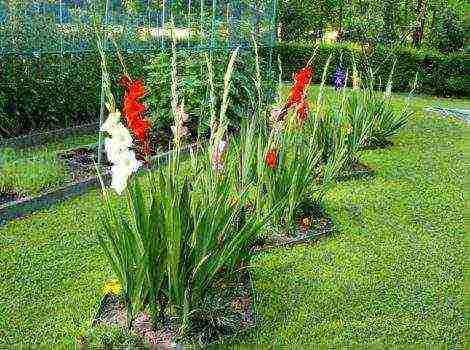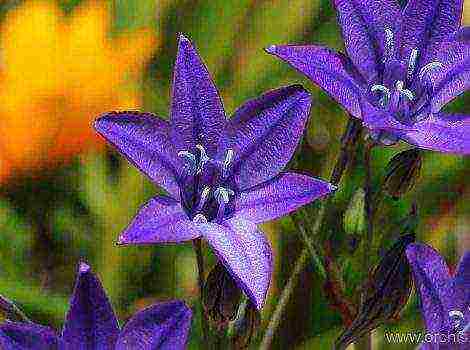Content [show]
Zephyranthes is a perennial plant native to South America and the West Indies. Prefers humid places, peat bogs, rainforest swamps. The growing season falls on the time when the wind begins to blow Zephyr - hence the official name of the plant, popularly called an upstart, homemade daffodil, room or rain lily.
The plant belongs to the Amaryllis family. The root system of zephyranthes is bulbous. Basal leaf rosettes consist of belt-shaped leaves 20-35 cm long and about 3 mm wide. The color is bright green.
Flowering lasts from April until almost the end of summer. Flowers of white, pink, yellow color are singly located on a long peduncle. Petals in the amount of 6 pieces have a pointed shape. The pith consists of yellow stamens of equal length. The diameter of the opened flower is 4-8 cm. After 1-3 days, the flower is replaced with a new one.
Planting and transplanting zephyranthes at home

How to transplant Zephyranthes
There is no need to transplant immediately after purchase if the bulb has not yet taken up all the free space in the pot.
Transplanting and planting a plant is usually carried out in the spring. The bulbs must be freed from dry scales, rotted or dry areas must be removed and kept in a fungicide solution for 30 minutes.
Use a shallow, wide container for planting. Usually several bulbs are planted in one bowl at once.
The soil is needed loose, nutritious, with a neutral reaction. A mixture of turf, humus and sand in equal proportions is suitable.
Be sure to lay a drainage layer about 2 cm thick, consisting of fine expanded clay, brick chips, foam.
Fill the container up to half with soil, place the bulbs, keeping a distance of 3 cm between them, and cover with the substrate along the neck. Moisten the soil, avoiding getting water on the neck. After planting, place in a warm (25–29 ° C), bright (no direct sunlight) place.
How to care for zephyranthes at home
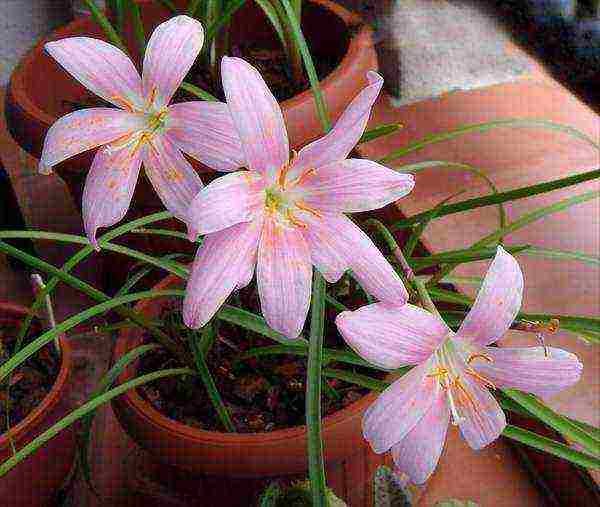
Zephyranthes flower home care photo
How to water
Watering is necessary regularly: carry it out as soon as the top layer of the soil dries up. Avoid stagnant water as the bulb will start to rot. If you skip a couple of waterings, the plant, on the contrary, will begin to bloom faster. Water liberally during flowering. When the aboveground part withers, watering is stopped altogether. In hot, dry weather, you can spray the leaves and flowers with a fine spray bottle. For water treatments, use soft, warm water.
Top dressing
With the appearance of the first leaves after a dormant period, complex mineral fertilizers are applied every 2 weeks. During flowering, fertilize every 10 days. After flowering, the frequency of top dressing should again be 2 weeks and continue until the aerial part dries up so that the bulb is stocked with nutrients.
Air temperature and lighting
The optimum air temperature during the period of active growth will be in the range of 25-29 ° C.
The best spot is illuminated southeast or southwest window sills. Protect from direct sunlight.
Bloom
The onset of flowering of each particular plant depends on a number of factors: variety, duration of the dormant period, individual characteristics of the plant and external conditions. In some species, peduncles appear with the appearance of leaves, in others after. Although a single flower pleases only 1-3 days, each bulb contains several arrows and releases them one by one, giving the impression of continuous flowering (especially if there are several bulbs in one pot at once).
After flowering, cut the peduncle, leaving 5-7 cm in length, and when it dries up, you must carefully twist it. Dead plant parts should be promptly removed (dried flower stalks, cut off dry leaves before dormancy) to prevent the development of various infections.
Dormant period
The dormant period of zephyranthes can occur in December-February or September-November. The leaves will begin to wither and fall off. It is necessary to stop watering and place the container with the plant in a dark place with an air temperature in the range of 12-14 ° C.
Why Zephyranthes does not bloom at home
- Too voluminous pot - the bulb "fattens" and does not bloom. Transplant into a tighter pot, do not rush to remove the daughter bulbs. Many growers recommend replanting the plant every 5 years.
- Incorrect lighting. Constant exposure to the shade or direct sunlight will negatively affect flowering.
- During the dormant period, the humidity is high. Watering at this time is not needed, and the place of detention should be cool, with good ventilation.
- An excess of nutrients also results in a lack of flowering. It is necessary to adhere to the correct feeding regime.
- If the root collar is covered with earth, the flower will not bloom.
Zephyranthes diseases and pests
Fusarium (red rot) is a dangerous fungal disease, manifested by rotting of the root system, wilting and yellowing of the leaves. The infected bulb must be destroyed along with the earthen clod. Keep healthy ones in Maxim for about half an hour and plant them in a container with a new substrate. Do not water for a while.
- Excessive watering leads to rotting of the bulbs - carry out an emergency transplant by cutting off the affected areas of the bulbs and treating them with phytosporin.
- Due to lack of moisture, the leaves turn yellow and wither - adjust the watering.
The amaryllis bug is a small insect that feeds on plant sap, which leads to yellowing, wilting, and leaf fall. It is necessary to carry out an insecticide treatment. If the bulb is severely affected, it will have to be destroyed.
The spider mite is a sucking insect that can be recognized by the presence of cobwebs and drying of the leaves. For prevention purposes, it is necessary to humidify dry air. Treat the affected plant with an insecticide.
The soft false shield is a convex insect about 4 mm long.First of all, it is necessary to remove pests mechanically - moisten a cotton pad with soapy water and wipe the leaves of the plant, window, windowsill. Then treat the zephyranthes with an insecticide.
Whitefly are small whitish insects similar to moths. They mainly settle on the underside of the leaves. Move the plant to a cooler place (whiteflies don't like low temperatures) and spray with an insecticide.
Breeding zephyranthes
Seed and vegetative (separation of bulbs) propagation is possible.
Growing from seeds
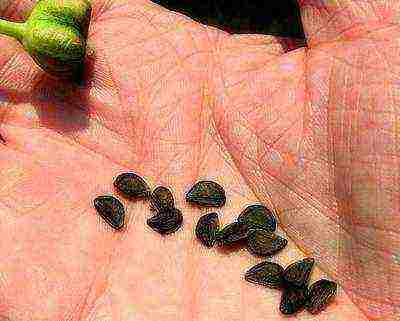
Zephyranthes seeds photo
To get the seeds yourself, you need to cross-pollinate. Seeds ripen in seed pods for 2 months. It is necessary to sow immediately after collection in bowls with soil for amaryllis with the addition of 1 part of peat.
- The seeding depth is 1 cm, keep a distance of 2-3 cm between them.
- Cover the crops with a bag or glass, place in a dark place and maintain the air temperature within 25 ° C.
- Ventilate the greenhouse, keep the soil moist with regular spraying.
- Expect seedlings for 20-25 days.
- When the seeds germinate, the shelter must be removed and the container placed in a bright place without direct sunlight.
- Plant the bulbs in separate pots in the spring. Plants grown from seeds will delight with flowering for 3-4 years of life.
Transplant of Zephyranthes babies

How to plant zephyranthes photo bulbs
When transplanting, separate the daughter bulbs. Separate bulbs that have their own roots. You can plant about 10 bulbs in one bowl. The soil and maintenance is the same as for adult plants.
Types of zephyranthes with photos and descriptions
In the natural environment, there are about 90 species of plants, and about 10 are cultivated culturally. Consider the most popular of them.
At home, all types of zephyranthes grow equally well, but on the windowsills you can most often see the popular indoor varieties described below.
Zephyranthes snow-white or Candida Zephyranthes candida
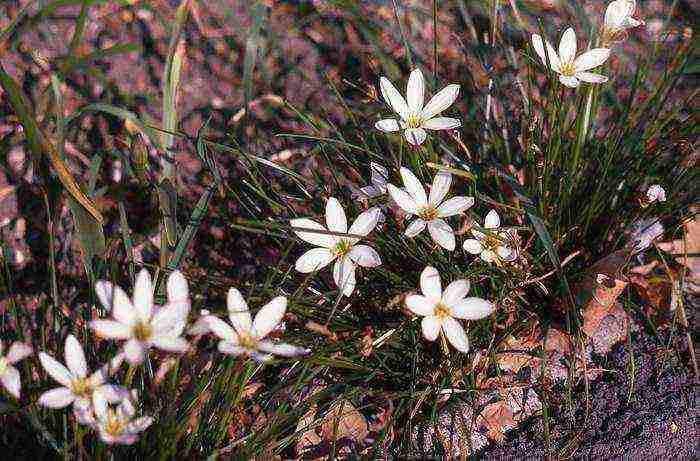
Zephyranthes white Zephyranthes candida
The diameter of the bulb is about 3 cm. The aboveground part reaches a height of 3 m. Flowering occurs in July-October. The diameter of the white rim is 6 cm.
Zephyranthes golden Zephyranthes aurea

Zephyranthes golden Zephyranthes aurea photo
In addition to indoor cultivation, the flower can be planted in open ground in the southern regions. Flowers are yellow, funnel-shaped. Corolla diameter is 8 cm. Flowering occurs in December-January.
Zephyranthes rosea
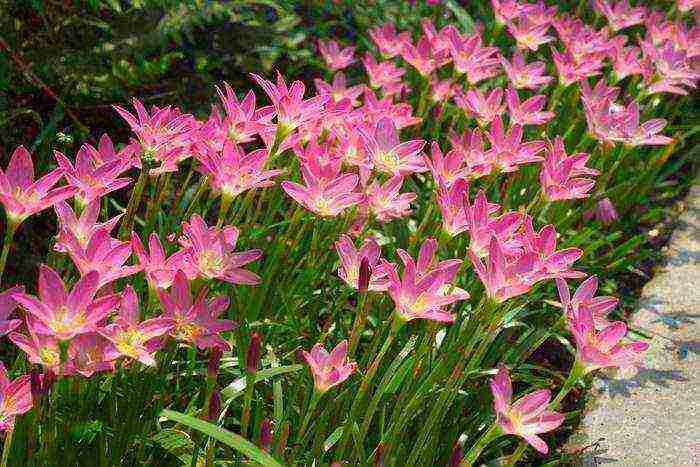
Zephyranthes rosea, pink or Lindley Zephyranthes rosea photo
Differs in purple-pink flowers. The corolla is about 7 cm in diameter.
Zephyranthes powerful Zephyranthes robusta
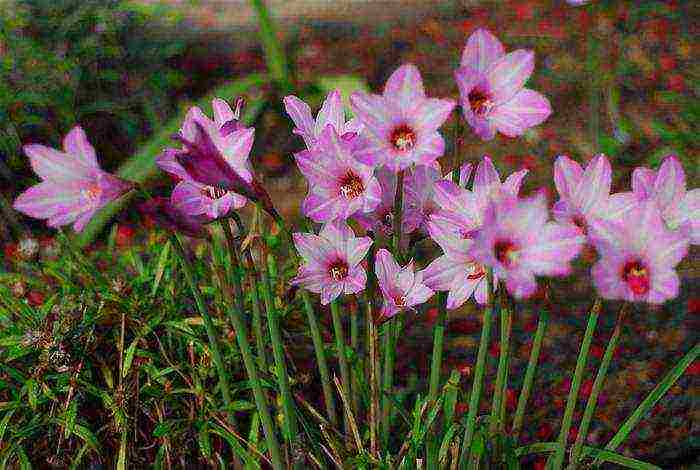
Zephyranthes powerful Zephyranthes robusta photo
The bulb is 4 cm in diameter. The dormant period clearly falls on September-November. Bloom: April-July. The long petals are pastel pink. The diameter of the corolla is 5-7 cm.
Zephyranthes multi-colored Zephyranthes versicolor
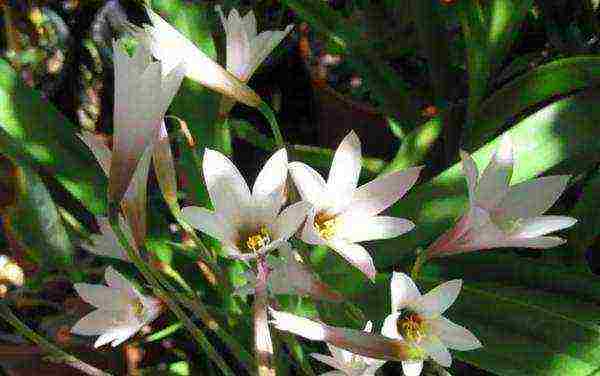
Zephyranthes multicolored Zephyranthes versicolor photo
It has flowers of a creamy white color with reddish edges. The bulb is covered with a dark film on the outside. Flowering occurs in January.
Zephyranthes atamasca

Zephyranthes atamasca photo
It has small ovoid bulbs with a diameter of 20 mm. Flowers are small, white in color. Blooms all spring.
Zephyranthes citrina
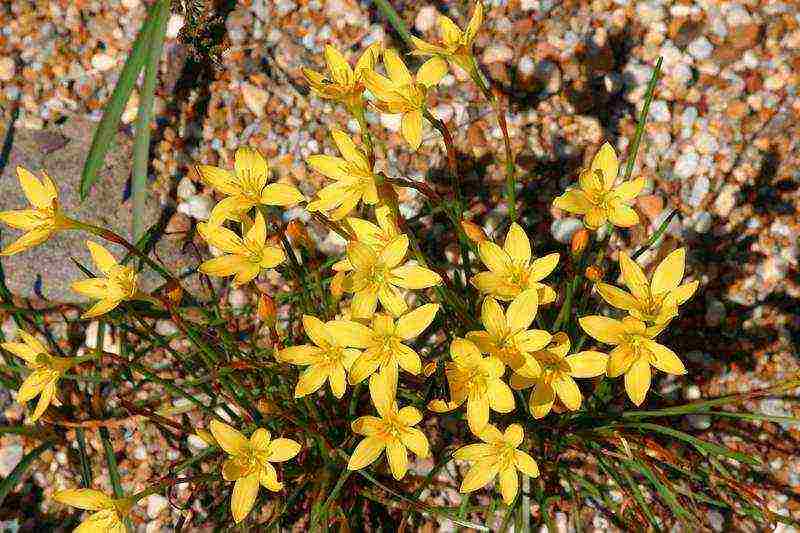
Zephyranthes lemon Zephyranthes citrina photo
The bulb is medium in size. The flowers are small with lemon-colored petals, flowering occurs in winter.
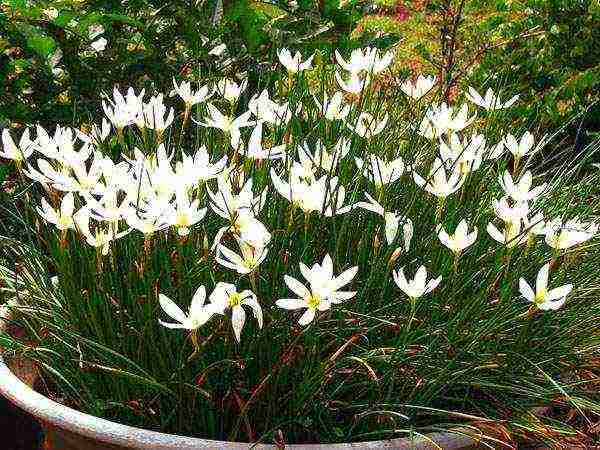 In warm regions of the American continent, perennial bulbous marshmallows are unpretentious, beautifully flowering plants for flower beds, decorating alpine slides and green lawns. But in central Russia, zephyranthes, home care sand which is as uncomplicated as in the open field, it is a pot culture found on city windowsills.
In warm regions of the American continent, perennial bulbous marshmallows are unpretentious, beautifully flowering plants for flower beds, decorating alpine slides and green lawns. But in central Russia, zephyranthes, home care sand which is as uncomplicated as in the open field, it is a pot culture found on city windowsills.
Description and features of the indoor flower zephyranthes
To distinguish zephyranthes from other popular bulbous plants, help:
- elongated leaves extending from the neck of the bulb;
- erect or lodging peduncles about 25 cm long;
- single flowers of various colors, in shape resembling crocuses or sparaxis, better known to gardeners.
The diameter of the corolla with a tubular bracts is 7–9 cm, and the color of the petals and core depends on the variety and variety of zephyranthes. Florists consider the almost lightning-fast development and the appearance of peduncles with buds to be a unique ability of the plant. But after the end of flowering, the developing leaves most often die off, and the zephyranthes plunges into "sleep" for several months.
These cultural features must be taken into account when caring for zephyranthes at home.
Zephyranthes flower care during the growing season, flowering and dormancy
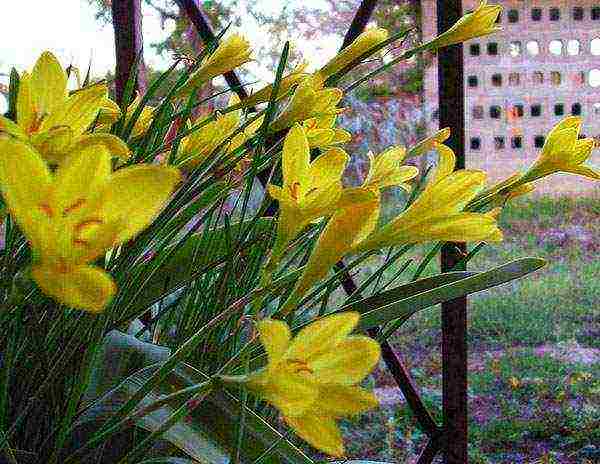 With the advent of buds, zephyranthes needs bright sun and warmth. The plant is not afraid of southern windows, and at a suitable air temperature, a flower from the subtropics of America grows well on a balcony and even in open ground, for example, in a summer cottage.
With the advent of buds, zephyranthes needs bright sun and warmth. The plant is not afraid of southern windows, and at a suitable air temperature, a flower from the subtropics of America grows well on a balcony and even in open ground, for example, in a summer cottage.
With proper care of the marshmallow plant, planting in a well-lit area will ensure rapid growth of mothers and the emergence of new bulbs.
In addition to the bright sun, during the growing season, the bulbous culture requires:
- air heated to 20–25 ° C;
- regular fertilization, at least once every 10-14 days;
- getting warm, settled moisture.
Watering is carried out as the top, 2-centimeter layer of the substrate dries up. If there is more moisture than the plant requires, its stagnation and decay of the branched system of roots and the bottom of the bulb cannot be avoided.
In the summer, when the air is dry and hot, spraying greenery is an effective addition to watering. This home care measure for marshmallows, as shown in the photo, helps keep foliage and flowers fresh even outdoors.
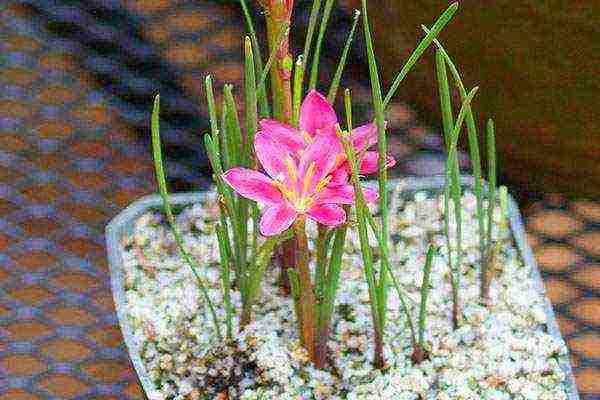 By September, Zephyranthes begins to prepare for hibernation. In most species of this bulbous culture, the state of dormancy lasts for several months. The impetus for awakening in natural conditions is seasonal climate change. At home, regulate the course of life, changes in the care of the zephyranthes flower and temperature fluctuations.
By September, Zephyranthes begins to prepare for hibernation. In most species of this bulbous culture, the state of dormancy lasts for several months. The impetus for awakening in natural conditions is seasonal climate change. At home, regulate the course of life, changes in the care of the zephyranthes flower and temperature fluctuations.
When the leaves wither and fall on the plant, this means that it is time to transfer the zephyranthes to a cool room, where it will be dry and dark. The optimum temperature can range from 5-14 ° C, but if it drops below, there is a risk of freezing the bulbs.
During the dormant period, the plants do not need full-scale watering, they are not fed. But to avoid drying out the bulbs, the soil is sometimes carefully moistened with settled water.
With the onset of spring, the plant's life processes are activated, the first green foliage appears, and after it the buds. At this time, the pot is transferred to the light and the feeding and watering, interrupted for the winter, begin. Zephyranthes care is back on track.
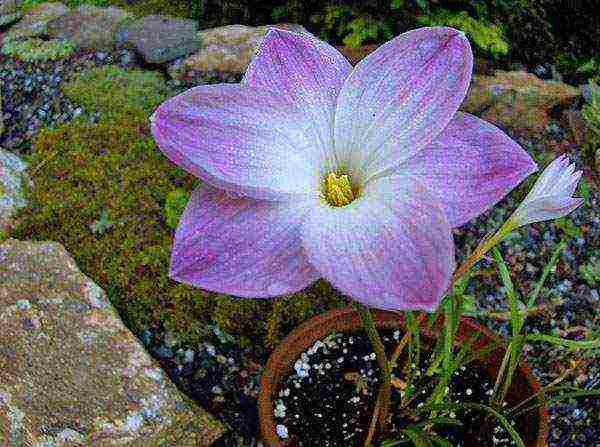 In some species, the leaves do not fall off for the winter. Therefore, they are not removed in the dark, but they try to keep them at low temperatures, slightly limiting watering.
In some species, the leaves do not fall off for the winter. Therefore, they are not removed in the dark, but they try to keep them at low temperatures, slightly limiting watering.
Planting and caring for zephyranthes during flower reproduction
Every year, several small daughter bulbs are formed around adult zephyranthes bulbs, which are easy to separate and give life to new plants.
 If planting and caring for the zephyranthes were carried out correctly, young bulbs quickly lay the rudiments of peduncles and open the buds a year after separation from the mother plant.
If planting and caring for the zephyranthes were carried out correctly, young bulbs quickly lay the rudiments of peduncles and open the buds a year after separation from the mother plant.
The easiest way to collect small bulbs is in the fall, when the transplant is carried out. For planting, take wide boxes or pots, lay a drainage layer on their bottom, and pour a mixture of equal shares on top of it:
- humus;
- sand;
- peat;
- turf land.
It is good if the soil was sterilized before planting the zephyranthes and caring for the bulbous plant. This will exclude the infection of the bulbs with fungi or damage to the rhizomes by pests.
Zephyranthes are relatively small plants, so they look much more spectacular in group plantings, where there are from 8 to 15 bulbs nearby.When planting in the ground, be sure to pay attention to the fact that the thin, graceful neck of the bulb remains above the surface of the substrate.
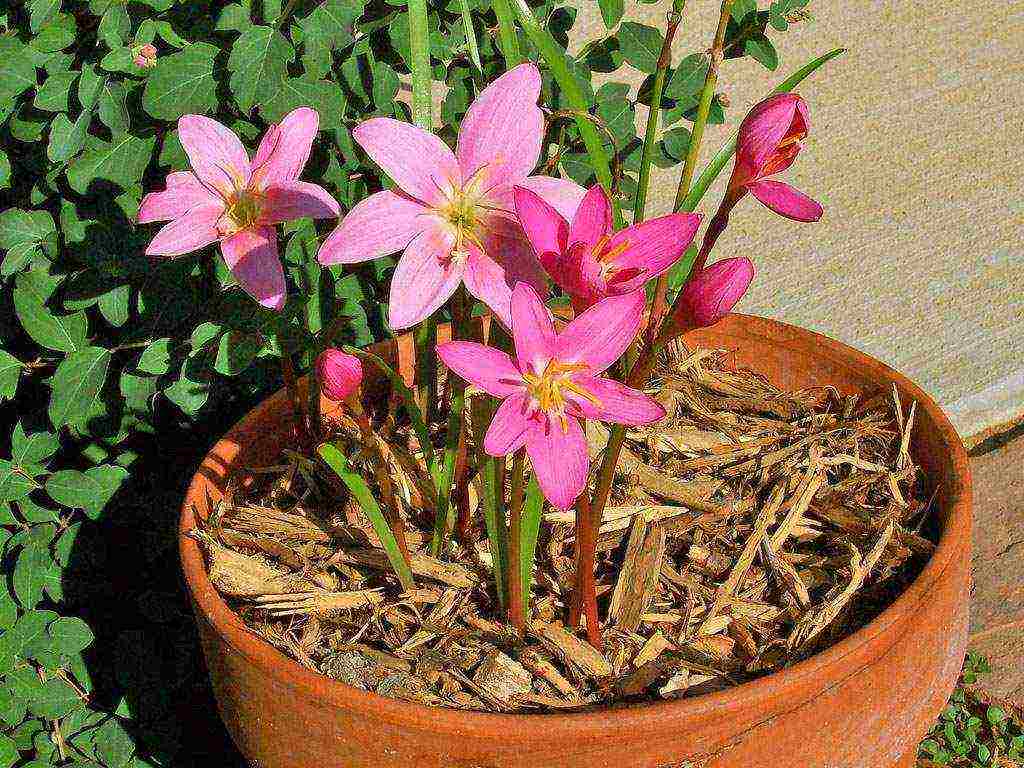 Similarly, planting crops in the open field. If the zephyranthes plants are well-groomed, as in the photo, at home they can be pollinated and give seeds. From the moment of artificial pollination to the collection of sowing material, it takes about 60 days. Sowing is carried out in the same season, otherwise the germination of seeds drops sharply.
Similarly, planting crops in the open field. If the zephyranthes plants are well-groomed, as in the photo, at home they can be pollinated and give seeds. From the moment of artificial pollination to the collection of sowing material, it takes about 60 days. Sowing is carried out in the same season, otherwise the germination of seeds drops sharply.
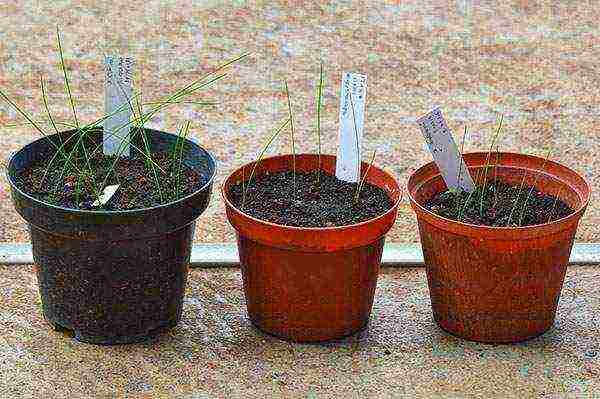 Seeds are spread on the surface of a loose finished substrate at a distance of 2-3 cm from each other, lightly sprinkled with soil and placed in partial shade. At a temperature of about 22–24 ° C in a greenhouse, the seedling boxes are kept for up to 4 weeks. In most species, after this time, the first young shoots appear. Caring for zephyranthes bears good fruit. Flower specimens grown from seeds open their buds for the first time in the third year of life.
Seeds are spread on the surface of a loose finished substrate at a distance of 2-3 cm from each other, lightly sprinkled with soil and placed in partial shade. At a temperature of about 22–24 ° C in a greenhouse, the seedling boxes are kept for up to 4 weeks. In most species, after this time, the first young shoots appear. Caring for zephyranthes bears good fruit. Flower specimens grown from seeds open their buds for the first time in the third year of life.
Video about upstart flower

Zephyr flower - so called zephyranthes at home, in Central America. In the tropics, this plant waits out a drought, hiding the bulbs in the ground, and in the rainy season it releases leaves and blooms vigorously. Is it possible to grow zephyranthes at home - in an ordinary city apartment? This is quite possible if you follow the simple rules for caring for a flower.
Description of Zephyranthes
Zephyranthes is a tropical bulbous plant. Belongs to the Amaryllis family. Homeland - South and Central America. The name translates as "flower of the west wind". In different countries, it is also called a water lily, a domestic daffodil, a rain flower. In Russia, it is nicknamed an upstart because of the rapid appearance of flowers - flower stalks are crowned with flowers within 1-2 days after release.
The rapid appearance of flowers explains another name for zephyranthes - "upstart"
The leaves of the zephyranthes are basal, narrow, up to 30–40 cm in length, the peduncle is 25–30 cm, on it are single crocus-shaped flowers with a diameter of 8–10 cm, pink, white, red, yellow (depending on the variety). The bulbs are from 1 to 5 cm in diameter, rounded, with brown scales, poisonous, therefore pests do not like it. Several peduncles grow from the bulb.In nature, there are about 90 species of zephyranthes, 10 are grown at home.The most common of them are white zephyranthes and large-flowered zephyranthes.
Flower video
Popular "home" varieties
- Zephyranthes white. Leaves 45-50 cm long, funnel-shaped white flowers 6-8 cm in diameter. Blooms in July-October.
- Zephyranthes golden. Leaves 30–35 cm long, slightly wider in the middle, flowers 7–9 cm in diameter, blooms in December – January.
- Zephyranthes large-flowered. The leaves are 20–40 cm long, the peduncle is 30–35 cm, the flowers are pink, about 8–10 cm in diameter, the stamens are orange. Blooms in April - July. The bulbs are large - up to 5 cm in diameter.
- Zephyranthes pink. Plant up to 20 cm tall, with shiny leaves and delicate pink flowers.
- Zephyranthes Powerful (Powerful PinTo). This species has narrow leaves - up to 30 cm, peduncle - 20 cm.The diameter of pink flowers is 6 cm.
Color variety in the photo
Seasonal growing conditions - table
Features of planting and transplanting
Zephyranthes transplant is an annual procedure, carried out at the beginning of the dormant period, when the pot is filled with baby bulbs. However, a pot that is too spacious for planting a plant should not be taken - it develops better in some cramped conditions. Step by step process:
- Be sure to fill one third of the pot with drainage (expanded clay or pebbles), which protects the flower from stagnant water.
A prerequisite for planting zephyranthes is pot drainage
- Prepare the soil: humus, sand, turf soil, mixed in equal parts.
The soil for zephyranthes should be light and loose
- Remove the main plant from the ground, carefully separate the daughter bulbs with a sharp knife, process the cuts with crushed charcoal so as not to rot.
- If the bulb has a short neck, it must be completely immersed in the ground, if with a long one, let it protrude slightly from the ground.
- You can plant 10-12 bulbs in one container, which will ensure a beautiful and continuous flowering.
Several zephyranthes bulbs can be planted in one pot to increase the decorative effect of the composition.
- After transplanting, watering the flower should be very rare, since the bulbs can rot from excess water.
If the newly purchased zephyranthes feels spacious in a pot, a transplant is not required.
Plant care
Lighting
Like all tropical plants, a zephyranthes needs a lot of light, and it also tolerates direct sunlight. For cultivation, east and west windows are suitable. In the summer, the upstart can be sent to the balcony. Some gardeners in the summer plant zephyranthes in an open flower bed in the country.
Zephyranthes loves the sun, so a window sill is the right place for him
Temperature and watering
The optimum temperature for the proper development of zephyranthes is + 20 ... + 26 ° С. It's summer. In winter, depending on the species, the marshmallow drops or leaves the leaves. In the first case, it must be removed to a dark and cool place with a temperature of + 8 ... + 14 ° C (the basement or the lower shelf of the refrigerator will do). It is sometimes necessary to moisten the soil so that the bulbs do not dry out. When new leaves appear, the marshmallows are put back.
If the plant does not shed its leaves, then it is left in a bright place, but it should still be cool (about +16 ° C). Watering is rarely done.
The winter time, when the flower does not grow, is called the dormant period. It occurs in most varieties of upstart in September - October, lasts at least 2 months, more often up to six months.
In summer, the flower is watered often and abundantly. The frequency and volume of water depends on the degree of drying of the soil. It should be remembered that zephyranthes does not tolerate waterlogging and even more stagnant water. In addition to watering, spraying is needed - once every 2 days. Water for procedures is soft, kept for at least 6 hours.
Top dressing
Complex fertilizers for flowering plants are suitable for Zephyranthes
Zephyranthes responds favorably to feeding. They need to be carried out every 10 days during the active season - from the emergence of sprouts in the pot until the end of flowering. Liquid flower fertilizers with a mineral complex (Merry Flower Girl, Kemira-Lux, Agricola) are suitable for this. Organic fertilizers can also be used, but with care (for example, unripe manure will lead to rotting of the bulb). Ash contains many elements necessary for the plant. A nutrient solution can be prepared by adding 1 tbsp. a spoonful of ash in 1 liter of water.
Fertilization rules for indoor flowers:
- an oversupply of fertilizer for indoor plants is just as harmful as a shortage;
- plants absorb fertilizers well only in the active phase of growth and flowering;
- in winter, feeding should be rare due to low natural light, due to which the absorption of nutrients is slowed down;
- you should not carry out top dressing even in a sultry time;
- do not allow the fertilizer solution to hit the foliage;
- for young flowers, the concentration of fertilizer should be weaker than for those already rooted;
- you cannot fertilize the plants without thoroughly watering the soil, if this is not done, you can burn the roots.
Bloom
From May to October, Zephyranthes pleases with flowers. They live only a few days, but since there are a lot of peduncles, the effect of a long flowering is created. After its end, the leaves die off, and a dormant period begins. It's time to transplant Zephyranthes.
Although a single zephyranthes flower does not live long, due to the abundance of peduncles, the effect of continuous flowering is created.
Dormant period
In one of the autumn months, the growth of the plant stops, the leaves dry, begin to fall off. A dormant period begins. Watering at this time should be stopped, and the pot should be placed in a dark, cool place (+ 8 ... + 14 ° С). At the same time, the bulbs remain in the ground; dry leaves must be removed.Zephyranthes "hibernation" lasts about 3 months. When new young leaves appear, the plant is returned to normal conditions and care is resumed.
Florist errors
If the plant develops slowly and does not please with flowers, then, perhaps, mistakes in agricultural technology were made. To stimulate the growth of zephyranthes and make the upstart bloom, it is necessary to correct the mistakes made. Why is the plant sick?
Problems in the care of zephyranthes and how to solve them - table
Pest control
Zephyranthes is quite resistant to pests, but under adverse conditions it can be attacked by insects.
Prevention and control of harmful insects - table
Insect pests in the photo
Reproduction
Bulbs
Zephyranthes bulbs diameter - 1 to 5 cm
The best way to propagate zephyranthes is with bulbs. They are formed in abundance in the main plant (up to 15 pieces). They are separated and planted in clay wide and low pots in the fall - during a flower transplant, observing the same algorithm of actions.
Before planting, the bulbs can be soaked in a growth stimulant, for example, Epine.
Seeds
There is another way of reproduction - by seeds. However, this requires artificial pollination. If everything succeeds, after 2 months the seeds will ripen in a fruit-box.
They quickly lose their germination, so you need to start planting immediately.
- Prepare the same soil as for the bulbs, adding 1 part peat.
- Spread the seeds on the ground, observing an interval of 2 cm between them, lightly sprinkle with damp soil.
- Cover the seed pot with foil, put in a shaded place with a temperature of about +22 ° C.
- The soil must be moistened at all times.
- Seedlings will appear in 3-4 weeks. Zephyranthes grown from seeds will bloom after 3–6 years.
Zephyranthes Seed Video
Florist reviews
Between flowering periods, Zephyranthes Lindley looks unremarkable: narrow long leaves and nothing else. As soon as it begins to bloom, you cannot take your eyes off the plant. It's easy to look after him. The plant reproduces by bulbs.
Zephyranthes is simply called the "upstart". This name was given to him for the fact that this flower blooms unusually. Today there is nothing, but in the morning you look, he threw away the arrow, and the next day he blossomed. I have this flower recently, my mother brought two species. At first, I was not particularly happy with this flower, because it looked like a decorative bow. But when they both bloomed, it looked just great. One blooms white, resembles a daffodil, and the second pink. Very beautiful flowers that do not require any special care. In order for it to bloom better, it must be transplanted. It blooms mainly in summer and for a very short time, but it is worth it to plant such a plant.
The flower took root, he liked it on the windowsill, he liked my leaving, and after a couple of months he pleased me with the first flowering. I was surprised, because nothing foreshadowed flowering, and then I suddenly noticed an arrow, and a couple of days later the first beautiful flower. Then another and another - how beautiful it is when several flowers bloom at once. Three years have passed since the moment a flower appeared in my house, and my flowers (yes, I now have three pots with this beauty) have gone through three moves, and everyone is alive, everyone is delighting with their flowering. I like the fact that the flower is completely unpretentious, it even loves direct sunlight, it likes to swim in the shower. I have a white bloom Zephyranthes and now I really want to buy a pink bloom. I recommend this flower - it is very easy to care for, but so beautiful, both during dormancy (the green is bright, like onion feathers), and during flowering.
Zephyranthes has been pleasing with its flowers for many years. Especially in early spring)) There is a pot, there is nothing but thin leaves, and then you wake up the next day, and an arrow is already climbing in the pot (hence the name upstart). But I like the name RAIN LILY better.Since in nature, the upstart usually blooms during the period of tropical rains)) I have a large-flowered upstart, there is almost no care for it, it stands in the scorching sun, however, it loves when it is well watered and sometimes sprayed)) I transplant it once every 2 years, in a pot a lot of bulbs are formed (therefore, I rewarded all my friends and acquaintances with bulbs), I leave myself the youngest bulb, but the more bulbs in 1 pot, the more arrows-flowers there will be))
I water it only once a week and a half. And he feels great, he stands on my windowsill, our side is not sunny, so he does not feel any inconvenience. His greens are interesting, like onions, my mother calls him so - onions. It reminds me of chives, only the greens of the zephyranthes are brighter, denser and juicier. Mine has not bloomed yet, but I hope that next summer it will please me with its flowers.
Zephyranthes, despite its tropical homeland, is an unpretentious plant, easily amenable to "home education". Simple rules of care will turn into a joy for flower growers - a bright and long flowering plant. Considering that different varieties of Zephyranthes bloom in all seasons, continuous home decoration can be ensured.
I never cease to be convinced that life is beautiful. Rate the article:
(6 votes, average: 3.2 out of 5)
Rain lily, upstart, zephyranthes are the names of the same flower that has taken root on our windowsills and in our front gardens.
Zephyranthes flower from the amaryllis family. Wet subtropics are a familiar habitat for him. Zephyranthes are medium-sized bulbous perennials with fast-growing peduncles, wide-open flowers.
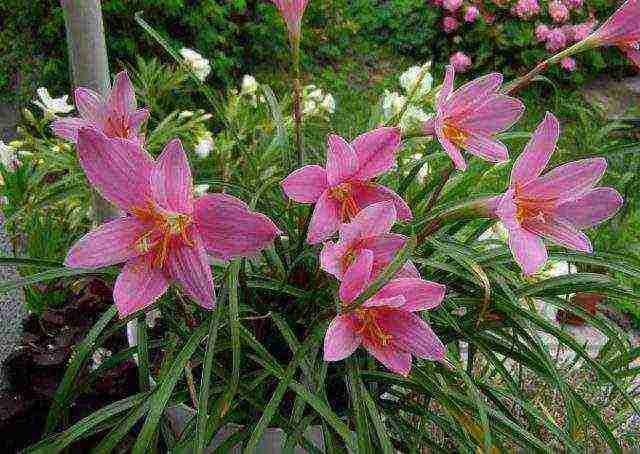 Zephyranthes flower in the photo
Zephyranthes flower in the photo
About 40 species of this flower are known. The most popular of these are:
- Zephyranthes is white, or snow-white. Differs in white flowers on a long peduncle. This species blooms from September to October.
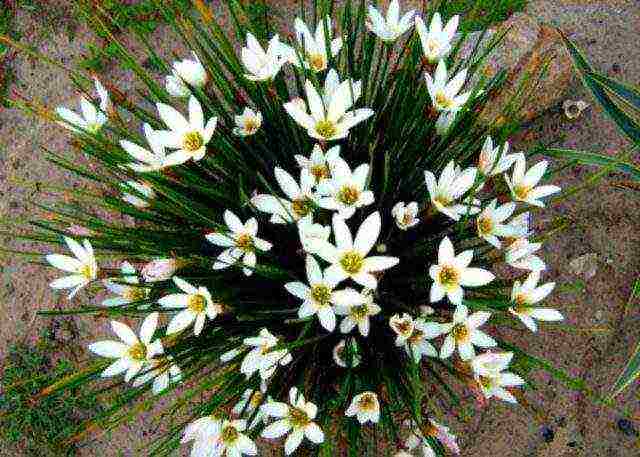
- Zephyranthes pink, or red-flowered. It blooms from April to May and has pink flowers.
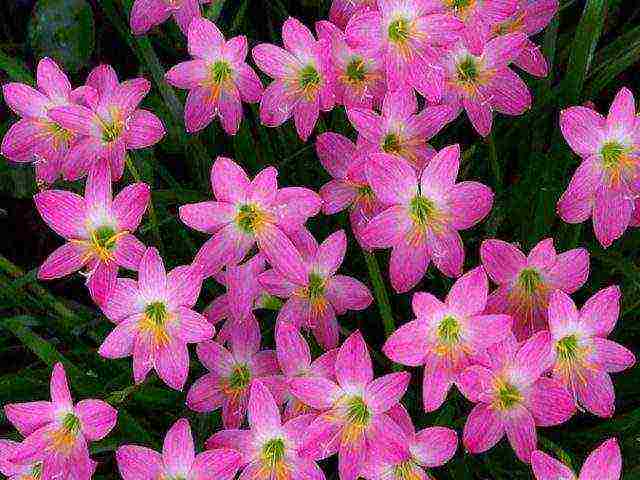
- Zephyranthes Lindley. Pink flowers, reaching a diameter of 7 cm. Blooms from July to August. The most capricious of all Zephyranthes.
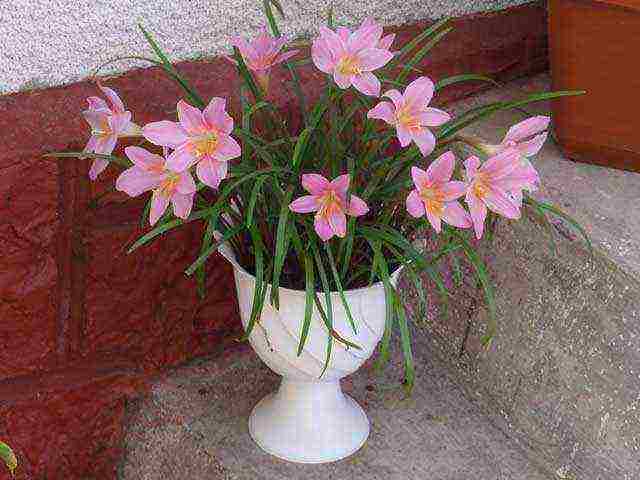
Zephyranthes flower: home care
Zephyranthes requires minimal maintenance.
- For harmonious growth, it is best to keep the plant in the east or west windows.
- In general, zephyranthes is a plant that is unpretentious to lighting. It is optimal to provide it with bright diffused light.
- Does not have any special temperature requirements. In winter, it is better if the temperature is slightly lower than the rest of the time.
- Almost any land is suitable for cultivation. The only condition is that the acidity should be in the range from 5.8 to 6.
- Watering should be moderate in volume and medium frequency. It is important to ensure that the soil does not dry out to the end, and to protect the zephyranthes from waterlogging and stagnant moisture.
- Spraying is not a vital procedure, but once or twice a week you can pamper your flower with a light, cold stream.
- In the spring, when the period of active growth begins and the time before flowering, it is necessary to feed the flower with solutions of organic fertilizers.
- To make the zephyranthes bloom especially impressive, you need dried bulbs, which were stored in the correct conditions in winter, and watered abundantly in the spring after planting in a wide pot. Several bulbs can be planted in one pot at once.
- Propagated by baby bulbs.
Zephyranthes: planting and care in the open field
Often, a tropical plant can be found in our front gardens. By the way, the flower grows outdoors only in warm climates.
The plant is transplanted into open ground at the beginning of summer, if it is not possible to keep it on the balcony. Planting of baby bulbs is carried out in prepared soil, which has good air permeability and fertility.The bulbs should be planted so that only a thin "neck" of the flower remains on the surface.
The successful growth of zephyranthes outdoors is entirely dependent on grooming.
- Watering is carried out with warm settled water under the root.
- Each time after watering, the soil must be loosened
- As soon as the zephyranthes begins to bloom, you need to feed him.
- Many gardeners recommend spraying the plant with an antimicrobial solution after planting, since the flower is most vulnerable in the open field. The most commonly used insecticide-fungicidal solutions.
Zephyranthes goes well with other flower crops.
Video: Zephyranthes, plant care
